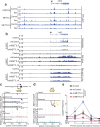METTL3-mediated chromatin contacts promote stress granule phase separation through metabolic reprogramming during senescence
- PMID: 38926365
- PMCID: PMC11208586
- DOI: 10.1038/s41467-024-49745-5
METTL3-mediated chromatin contacts promote stress granule phase separation through metabolic reprogramming during senescence
Abstract
METTL3 is the catalytic subunit of the methyltransferase complex, which mediates m6A modification to regulate gene expression. In addition, METTL3 regulates transcription in an enzymatic activity-independent manner by driving changes in high-order chromatin structure. However, how these functions of the methyltransferase complex are coordinated remains unknown. Here we show that the methyltransferase complex coordinates its enzymatic activity-dependent and independent functions to regulate cellular senescence, a state of stable cell growth arrest. Specifically, METTL3-mediated chromatin loops induce Hexokinase 2 expression through the three-dimensional chromatin organization during senescence. Elevated Hexokinase 2 expression subsequently promotes liquid-liquid phase separation, manifesting as stress granule phase separation, by driving metabolic reprogramming. This correlates with an impairment of translation of cell-cycle related mRNAs harboring polymethylated m6A sites. In summary, our results report a coordination of m6A-dependent and -independent function of the methyltransferase complex in regulating senescence through phase separation driven by metabolic reprogramming.
© 2024. The Author(s).
Conflict of interest statement
The authors declare no competing interests.
Figures






References
MeSH terms
Substances
Grants and funding
- P01AG031862/U.S. Department of Health & Human Services | National Institutes of Health (NIH)
- P30 CA016672/CA/NCI NIH HHS/United States
- R01 CA276569/CA/NCI NIH HHS/United States
- R35 GM153277/GM/NIGMS NIH HHS/United States
- P30 CA010815/CA/NCI NIH HHS/United States
- R01 GM129069/GM/NIGMS NIH HHS/United States
- P30 CA030199/CA/NCI NIH HHS/United States
- P01 AG031862/AG/NIA NIH HHS/United States
- OT2 OD030544/OD/NIH HHS/United States
- R00 AG065500/AG/NIA NIH HHS/United States
- R01 CA160331/CA/NCI NIH HHS/United States
- R01CA160331/U.S. Department of Health & Human Services | NIH | National Cancer Institute (NCI)
- R01CA276569/U.S. Department of Health & Human Services | NIH | National Cancer Institute (NCI)
- U2C DK119886/DK/NIDDK NIH HHS/United States
LinkOut - more resources
Full Text Sources

